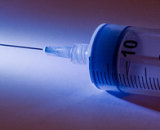From CleanCompetition.org.
WASHINGTON – Anti-doping experts continue to advance the science of future testing methods, building on the existing tests for growth hormone (GH) abuse in sport that have been successful in detecting dopers. Now, breaking research appearing in Clinical Chemistry, the journal of the American Association of Clinical Chemistry, shows that measuring IGF-1 as a biomarker of GH activity – through a chemistry technique known as liquid chromatography-tandem mass spectrometry (LC-MS/MS) – could increase the detection of and prevent GH doping by greatly enhancing inter-laboratory precision.
Athletes purportedly abuse GH to obtain its muscle-building and fat breakdown activity. Some actions of GH are the result of increased IGF-1 concentrations in the blood from the response of the liver to GH stimulation. Anecdotal evidence suggests that IGF-1 abuse may also be on the rise. Many sports stars and an estimated 5 percent of U.S. high school students are reported to have abused GH in an attempt to improve athletic performance and/or benefit from its perceived appearance-enhancing results. Side effects of this abuse include diabetes, aggravation of heart disease and abnormal organ growth, among others.
Two approaches have been developed for detecting GH in sport applications. The GH isoforms test, reported in Clinical Chemistry in 2009[1], has been successfully used to identify athletes abusing GH; however, it is limited by a short detection window. The biomarkers test, which measures serum concentrations of IGF-1 and another protein produced by the action of GH, has a detection window of weeks.
A team of researchers from five laboratories in three countries – who together form the IGF-1 LC-MS/MS Working Group – is led by Dr. Larry D. Bowers of the U.S. Anti-Doping Agency and funded by the Partnership for Clean Competition (PCC). The Working Group, established in 2011 as part of an initiative to develop new tests for GH biomarkers, has demonstrated that using LC-MS/MS instead of antibodies to measure IGF-1 concentrations increases measurement precision. For anti-doping purposes, the LC-MS/MS method has a second significant advantage over immunoassay – IGF-1 is identified in addition to being quantified. The PCC is hopeful that these results will contribute to the development and global adoption of the biomarkers GH test in anti-doping.
“Not only are these research results groundbreaking, but the selfless work and cooperation of the members of this Working Group, with the PCC’s support, demonstrates the power of collaborative research,” said Bowers, USADA Chief Science Officer and PCC Scientific Advisory Board Chair. “Bringing together top scientists and innovators in focused research to identify and resolve analytical problems is critical to advancing anti-doping science.”
Additionally, the PCC IGF-1 LC-MS/MS Working Group’s study demonstrates the benefits of the harmonization of – or ensuring uniformity among – clinical laboratory test results, an important healthcare issue about which AACC released a position statement in November 2013.
“In addition to being an important anti-doping testing advancement, new testing methodology arising from these findings could also aid in the diagnosis and treatment of disorders caused by the natural over- or under-production of GH,” said Andy Hoofnagle, M.D., Ph.D, and an associate professor of Laboratory Medicine and Pathology at the University of Washington and senior author on the paper. “The findings may also lead to clinical laboratories being able to better monitor the intra-individual biological variability, an approach increasingly used in both medicine and anti-doping science.”
For more information, visit CleanCompetition.org.





























